HI5003: Economics for Business - Construction Industry Analysis Report
VerifiedAdded on 2022/12/27
|10
|3343
|2
Report
AI Summary
This report provides an economic analysis of the construction industry, focusing on ADCO Constructions Pty Ltd. It begins with an introduction to the company and its operations, followed by an overview of the Australian construction industry's background, market structure, and factors influencing demand and supply. The report examines the industry's oligopolistic characteristics, the influence of income and prices on demand, and the impact of production costs and government policies on supply. It also discusses price elasticity of demand, considering factors like suppliers and legal frameworks. Finally, it explores the impacts of various economic events on the industry and concludes with a summary of key findings and recommendations. The report utilizes various sources to support its analysis, including academic journals and industry reports, and provides a comprehensive understanding of the economic dynamics within the construction sector.

Running Head: ECONOMICS FOR BUSINESS
ECONOMICS FOR BUSINESS
ECONOMICS FOR BUSINESS
Paraphrase This Document
Need a fresh take? Get an instant paraphrase of this document with our AI Paraphraser
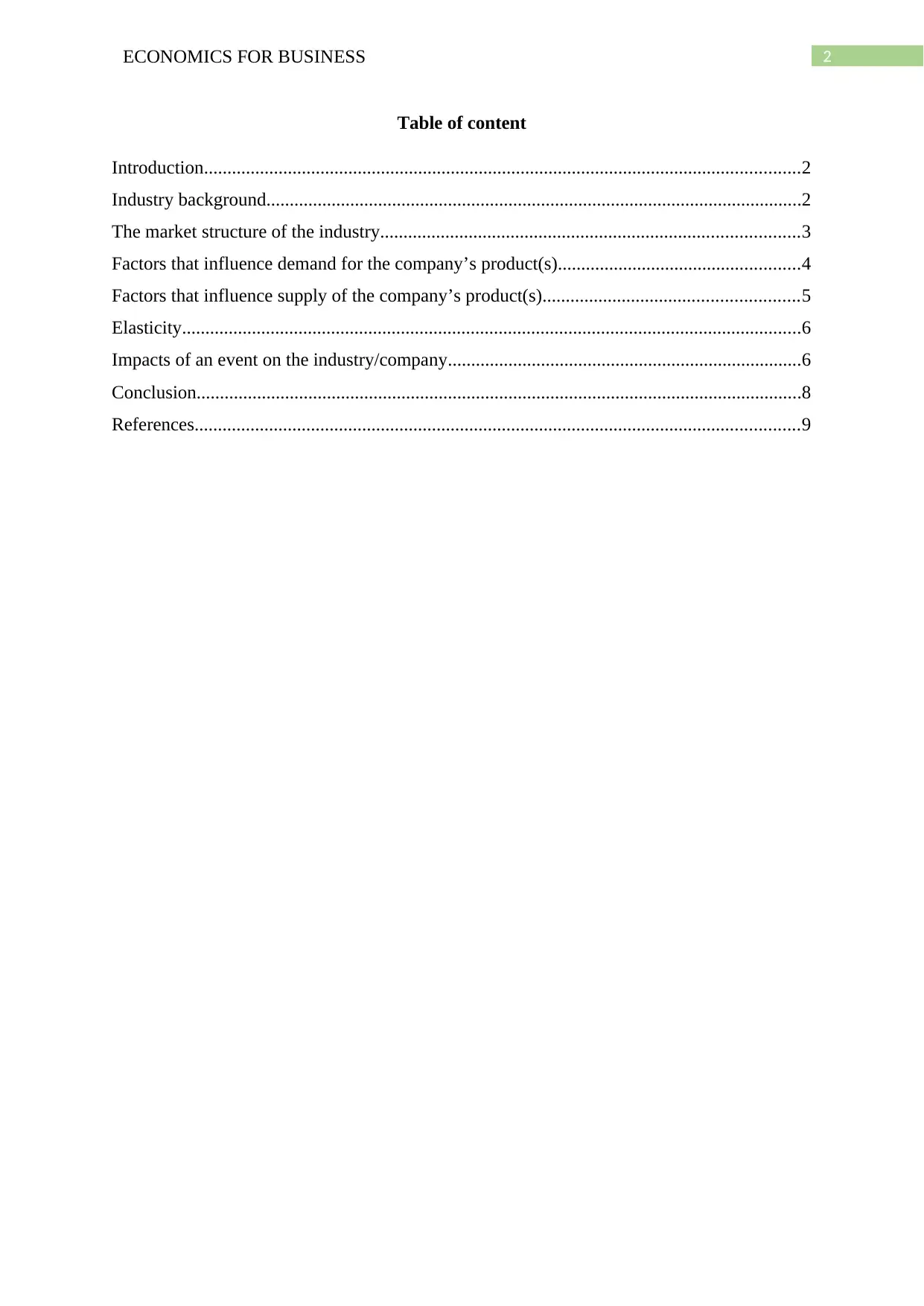
2ECONOMICS FOR BUSINESS
Table of content
Introduction................................................................................................................................2
Industry background...................................................................................................................2
The market structure of the industry..........................................................................................3
Factors that influence demand for the company’s product(s)....................................................4
Factors that influence supply of the company’s product(s).......................................................5
Elasticity.....................................................................................................................................6
Impacts of an event on the industry/company............................................................................6
Conclusion..................................................................................................................................8
References..................................................................................................................................9
Table of content
Introduction................................................................................................................................2
Industry background...................................................................................................................2
The market structure of the industry..........................................................................................3
Factors that influence demand for the company’s product(s)....................................................4
Factors that influence supply of the company’s product(s).......................................................5
Elasticity.....................................................................................................................................6
Impacts of an event on the industry/company............................................................................6
Conclusion..................................................................................................................................8
References..................................................................................................................................9
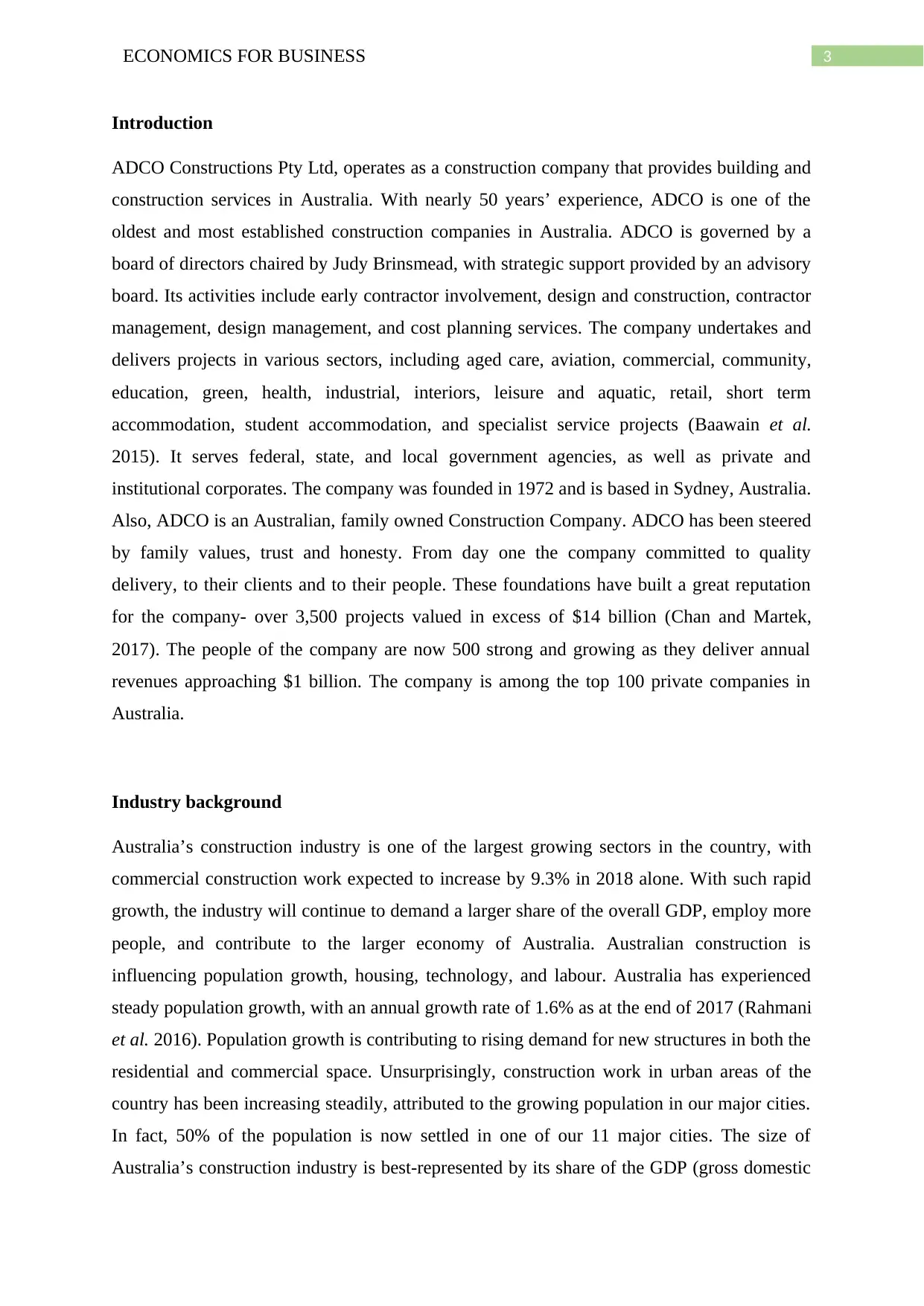
3ECONOMICS FOR BUSINESS
Introduction
ADCO Constructions Pty Ltd, operates as a construction company that provides building and
construction services in Australia. With nearly 50 years’ experience, ADCO is one of the
oldest and most established construction companies in Australia. ADCO is governed by a
board of directors chaired by Judy Brinsmead, with strategic support provided by an advisory
board. Its activities include early contractor involvement, design and construction, contractor
management, design management, and cost planning services. The company undertakes and
delivers projects in various sectors, including aged care, aviation, commercial, community,
education, green, health, industrial, interiors, leisure and aquatic, retail, short term
accommodation, student accommodation, and specialist service projects (Baawain et al.
2015). It serves federal, state, and local government agencies, as well as private and
institutional corporates. The company was founded in 1972 and is based in Sydney, Australia.
Also, ADCO is an Australian, family owned Construction Company. ADCO has been steered
by family values, trust and honesty. From day one the company committed to quality
delivery, to their clients and to their people. These foundations have built a great reputation
for the company- over 3,500 projects valued in excess of $14 billion (Chan and Martek,
2017). The people of the company are now 500 strong and growing as they deliver annual
revenues approaching $1 billion. The company is among the top 100 private companies in
Australia.
Industry background
Australia’s construction industry is one of the largest growing sectors in the country, with
commercial construction work expected to increase by 9.3% in 2018 alone. With such rapid
growth, the industry will continue to demand a larger share of the overall GDP, employ more
people, and contribute to the larger economy of Australia. Australian construction is
influencing population growth, housing, technology, and labour. Australia has experienced
steady population growth, with an annual growth rate of 1.6% as at the end of 2017 (Rahmani
et al. 2016). Population growth is contributing to rising demand for new structures in both the
residential and commercial space. Unsurprisingly, construction work in urban areas of the
country has been increasing steadily, attributed to the growing population in our major cities.
In fact, 50% of the population is now settled in one of our 11 major cities. The size of
Australia’s construction industry is best-represented by its share of the GDP (gross domestic
Introduction
ADCO Constructions Pty Ltd, operates as a construction company that provides building and
construction services in Australia. With nearly 50 years’ experience, ADCO is one of the
oldest and most established construction companies in Australia. ADCO is governed by a
board of directors chaired by Judy Brinsmead, with strategic support provided by an advisory
board. Its activities include early contractor involvement, design and construction, contractor
management, design management, and cost planning services. The company undertakes and
delivers projects in various sectors, including aged care, aviation, commercial, community,
education, green, health, industrial, interiors, leisure and aquatic, retail, short term
accommodation, student accommodation, and specialist service projects (Baawain et al.
2015). It serves federal, state, and local government agencies, as well as private and
institutional corporates. The company was founded in 1972 and is based in Sydney, Australia.
Also, ADCO is an Australian, family owned Construction Company. ADCO has been steered
by family values, trust and honesty. From day one the company committed to quality
delivery, to their clients and to their people. These foundations have built a great reputation
for the company- over 3,500 projects valued in excess of $14 billion (Chan and Martek,
2017). The people of the company are now 500 strong and growing as they deliver annual
revenues approaching $1 billion. The company is among the top 100 private companies in
Australia.
Industry background
Australia’s construction industry is one of the largest growing sectors in the country, with
commercial construction work expected to increase by 9.3% in 2018 alone. With such rapid
growth, the industry will continue to demand a larger share of the overall GDP, employ more
people, and contribute to the larger economy of Australia. Australian construction is
influencing population growth, housing, technology, and labour. Australia has experienced
steady population growth, with an annual growth rate of 1.6% as at the end of 2017 (Rahmani
et al. 2016). Population growth is contributing to rising demand for new structures in both the
residential and commercial space. Unsurprisingly, construction work in urban areas of the
country has been increasing steadily, attributed to the growing population in our major cities.
In fact, 50% of the population is now settled in one of our 11 major cities. The size of
Australia’s construction industry is best-represented by its share of the GDP (gross domestic
⊘ This is a preview!⊘
Do you want full access?
Subscribe today to unlock all pages.

Trusted by 1+ million students worldwide
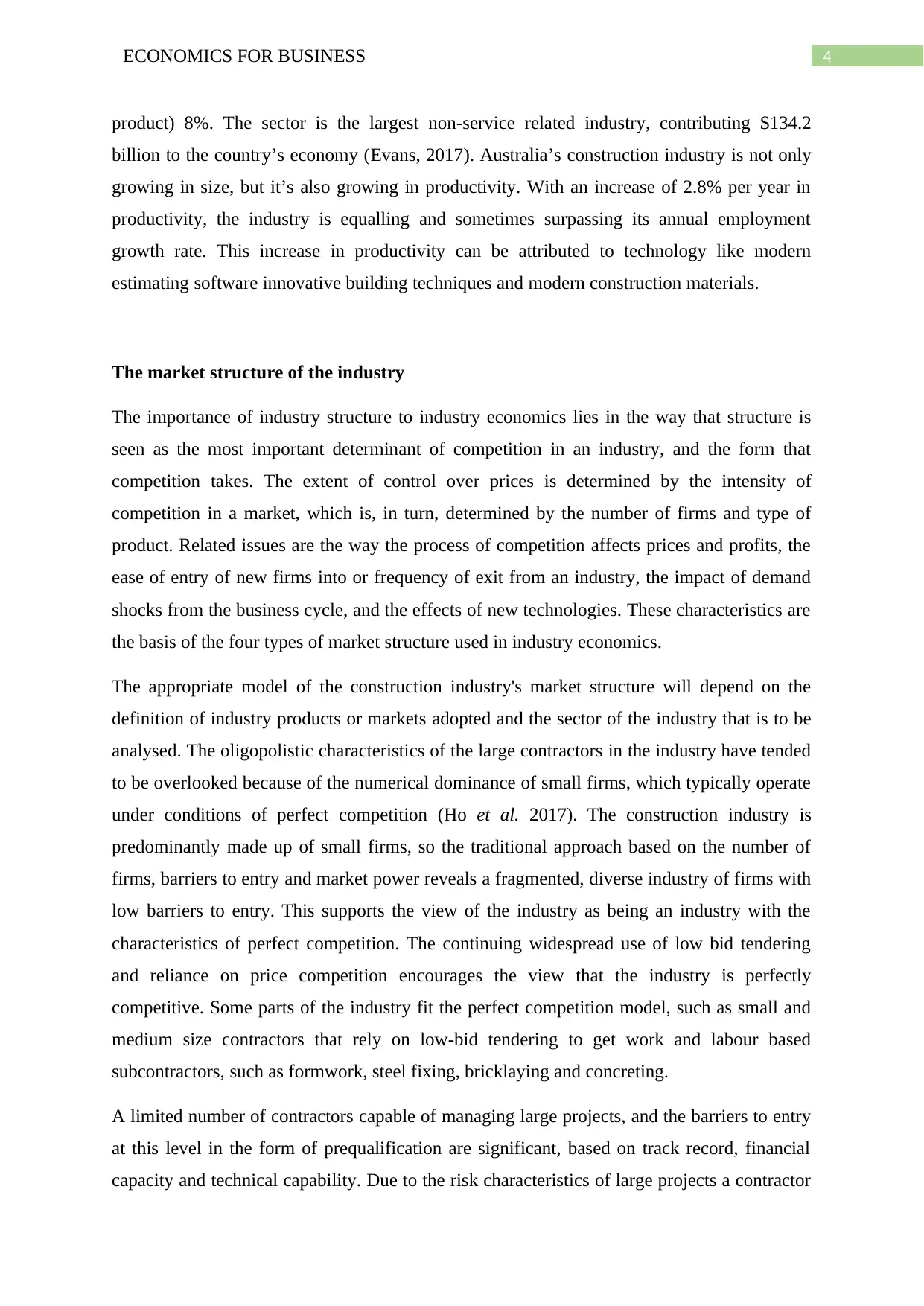
4ECONOMICS FOR BUSINESS
product) 8%. The sector is the largest non-service related industry, contributing $134.2
billion to the country’s economy (Evans, 2017). Australia’s construction industry is not only
growing in size, but it’s also growing in productivity. With an increase of 2.8% per year in
productivity, the industry is equalling and sometimes surpassing its annual employment
growth rate. This increase in productivity can be attributed to technology like modern
estimating software innovative building techniques and modern construction materials.
The market structure of the industry
The importance of industry structure to industry economics lies in the way that structure is
seen as the most important determinant of competition in an industry, and the form that
competition takes. The extent of control over prices is determined by the intensity of
competition in a market, which is, in turn, determined by the number of firms and type of
product. Related issues are the way the process of competition affects prices and profits, the
ease of entry of new firms into or frequency of exit from an industry, the impact of demand
shocks from the business cycle, and the effects of new technologies. These characteristics are
the basis of the four types of market structure used in industry economics.
The appropriate model of the construction industry's market structure will depend on the
definition of industry products or markets adopted and the sector of the industry that is to be
analysed. The oligopolistic characteristics of the large contractors in the industry have tended
to be overlooked because of the numerical dominance of small firms, which typically operate
under conditions of perfect competition (Ho et al. 2017). The construction industry is
predominantly made up of small firms, so the traditional approach based on the number of
firms, barriers to entry and market power reveals a fragmented, diverse industry of firms with
low barriers to entry. This supports the view of the industry as being an industry with the
characteristics of perfect competition. The continuing widespread use of low bid tendering
and reliance on price competition encourages the view that the industry is perfectly
competitive. Some parts of the industry fit the perfect competition model, such as small and
medium size contractors that rely on low-bid tendering to get work and labour based
subcontractors, such as formwork, steel fixing, bricklaying and concreting.
A limited number of contractors capable of managing large projects, and the barriers to entry
at this level in the form of prequalification are significant, based on track record, financial
capacity and technical capability. Due to the risk characteristics of large projects a contractor
product) 8%. The sector is the largest non-service related industry, contributing $134.2
billion to the country’s economy (Evans, 2017). Australia’s construction industry is not only
growing in size, but it’s also growing in productivity. With an increase of 2.8% per year in
productivity, the industry is equalling and sometimes surpassing its annual employment
growth rate. This increase in productivity can be attributed to technology like modern
estimating software innovative building techniques and modern construction materials.
The market structure of the industry
The importance of industry structure to industry economics lies in the way that structure is
seen as the most important determinant of competition in an industry, and the form that
competition takes. The extent of control over prices is determined by the intensity of
competition in a market, which is, in turn, determined by the number of firms and type of
product. Related issues are the way the process of competition affects prices and profits, the
ease of entry of new firms into or frequency of exit from an industry, the impact of demand
shocks from the business cycle, and the effects of new technologies. These characteristics are
the basis of the four types of market structure used in industry economics.
The appropriate model of the construction industry's market structure will depend on the
definition of industry products or markets adopted and the sector of the industry that is to be
analysed. The oligopolistic characteristics of the large contractors in the industry have tended
to be overlooked because of the numerical dominance of small firms, which typically operate
under conditions of perfect competition (Ho et al. 2017). The construction industry is
predominantly made up of small firms, so the traditional approach based on the number of
firms, barriers to entry and market power reveals a fragmented, diverse industry of firms with
low barriers to entry. This supports the view of the industry as being an industry with the
characteristics of perfect competition. The continuing widespread use of low bid tendering
and reliance on price competition encourages the view that the industry is perfectly
competitive. Some parts of the industry fit the perfect competition model, such as small and
medium size contractors that rely on low-bid tendering to get work and labour based
subcontractors, such as formwork, steel fixing, bricklaying and concreting.
A limited number of contractors capable of managing large projects, and the barriers to entry
at this level in the form of prequalification are significant, based on track record, financial
capacity and technical capability. Due to the risk characteristics of large projects a contractor
Paraphrase This Document
Need a fresh take? Get an instant paraphrase of this document with our AI Paraphraser
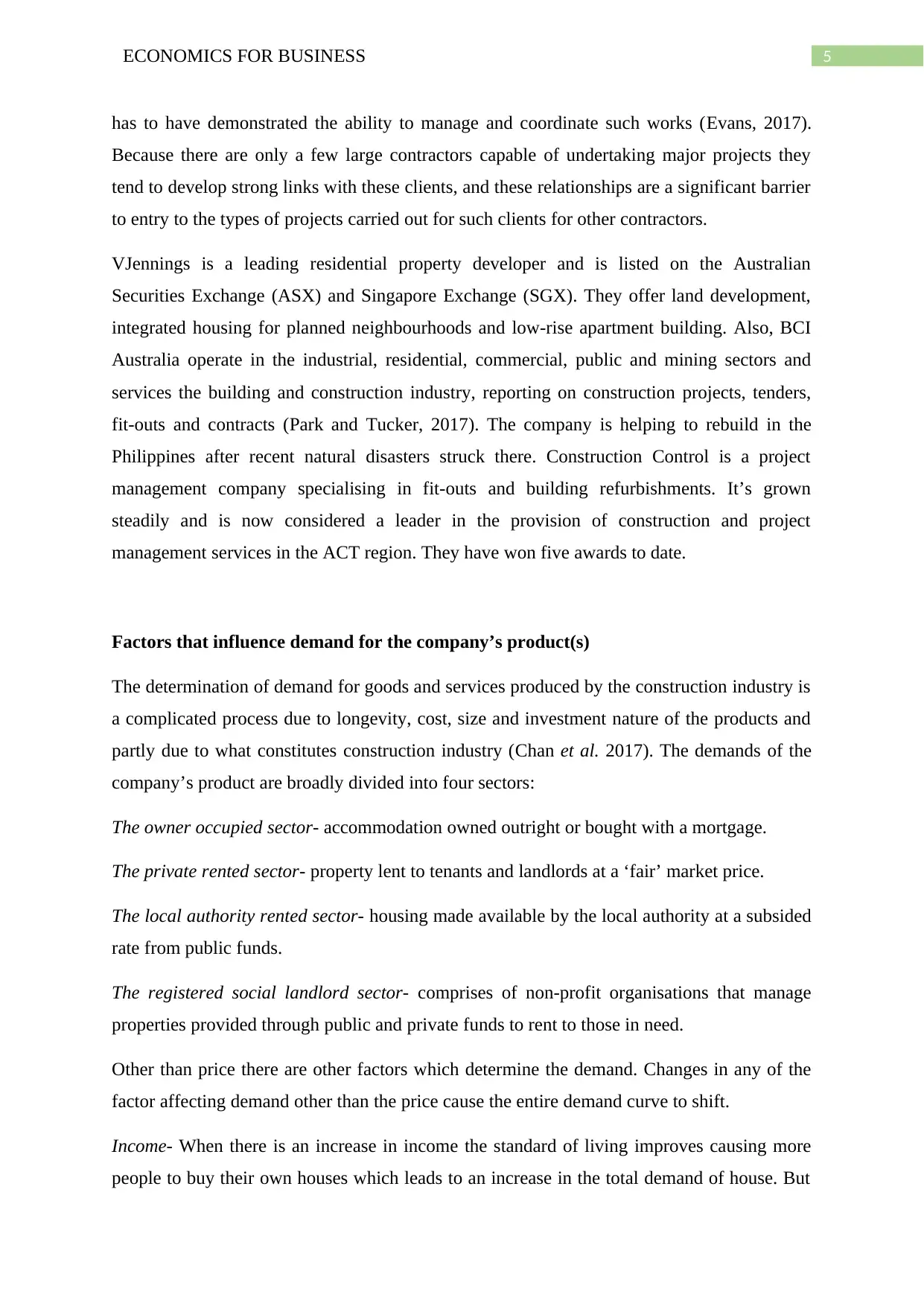
5ECONOMICS FOR BUSINESS
has to have demonstrated the ability to manage and coordinate such works (Evans, 2017).
Because there are only a few large contractors capable of undertaking major projects they
tend to develop strong links with these clients, and these relationships are a significant barrier
to entry to the types of projects carried out for such clients for other contractors.
VJennings is a leading residential property developer and is listed on the Australian
Securities Exchange (ASX) and Singapore Exchange (SGX). They offer land development,
integrated housing for planned neighbourhoods and low-rise apartment building. Also, BCI
Australia operate in the industrial, residential, commercial, public and mining sectors and
services the building and construction industry, reporting on construction projects, tenders,
fit-outs and contracts (Park and Tucker, 2017). The company is helping to rebuild in the
Philippines after recent natural disasters struck there. Construction Control is a project
management company specialising in fit-outs and building refurbishments. It’s grown
steadily and is now considered a leader in the provision of construction and project
management services in the ACT region. They have won five awards to date.
Factors that influence demand for the company’s product(s)
The determination of demand for goods and services produced by the construction industry is
a complicated process due to longevity, cost, size and investment nature of the products and
partly due to what constitutes construction industry (Chan et al. 2017). The demands of the
company’s product are broadly divided into four sectors:
The owner occupied sector- accommodation owned outright or bought with a mortgage.
The private rented sector- property lent to tenants and landlords at a ‘fair’ market price.
The local authority rented sector- housing made available by the local authority at a subsided
rate from public funds.
The registered social landlord sector- comprises of non-profit organisations that manage
properties provided through public and private funds to rent to those in need.
Other than price there are other factors which determine the demand. Changes in any of the
factor affecting demand other than the price cause the entire demand curve to shift.
Income- When there is an increase in income the standard of living improves causing more
people to buy their own houses which leads to an increase in the total demand of house. But
has to have demonstrated the ability to manage and coordinate such works (Evans, 2017).
Because there are only a few large contractors capable of undertaking major projects they
tend to develop strong links with these clients, and these relationships are a significant barrier
to entry to the types of projects carried out for such clients for other contractors.
VJennings is a leading residential property developer and is listed on the Australian
Securities Exchange (ASX) and Singapore Exchange (SGX). They offer land development,
integrated housing for planned neighbourhoods and low-rise apartment building. Also, BCI
Australia operate in the industrial, residential, commercial, public and mining sectors and
services the building and construction industry, reporting on construction projects, tenders,
fit-outs and contracts (Park and Tucker, 2017). The company is helping to rebuild in the
Philippines after recent natural disasters struck there. Construction Control is a project
management company specialising in fit-outs and building refurbishments. It’s grown
steadily and is now considered a leader in the provision of construction and project
management services in the ACT region. They have won five awards to date.
Factors that influence demand for the company’s product(s)
The determination of demand for goods and services produced by the construction industry is
a complicated process due to longevity, cost, size and investment nature of the products and
partly due to what constitutes construction industry (Chan et al. 2017). The demands of the
company’s product are broadly divided into four sectors:
The owner occupied sector- accommodation owned outright or bought with a mortgage.
The private rented sector- property lent to tenants and landlords at a ‘fair’ market price.
The local authority rented sector- housing made available by the local authority at a subsided
rate from public funds.
The registered social landlord sector- comprises of non-profit organisations that manage
properties provided through public and private funds to rent to those in need.
Other than price there are other factors which determine the demand. Changes in any of the
factor affecting demand other than the price cause the entire demand curve to shift.
Income- When there is an increase in income the standard of living improves causing more
people to buy their own houses which leads to an increase in the total demand of house. But
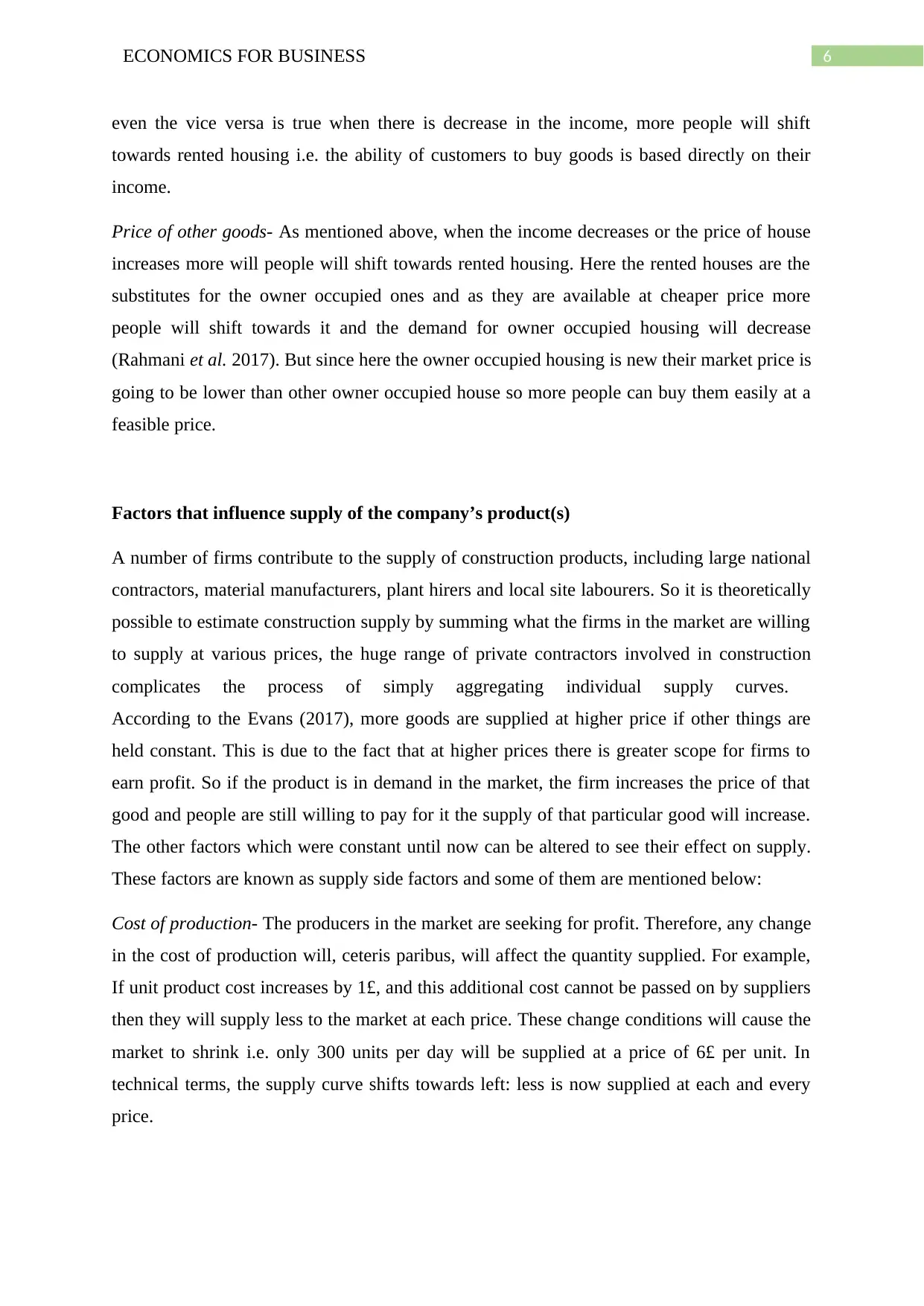
6ECONOMICS FOR BUSINESS
even the vice versa is true when there is decrease in the income, more people will shift
towards rented housing i.e. the ability of customers to buy goods is based directly on their
income.
Price of other goods- As mentioned above, when the income decreases or the price of house
increases more will people will shift towards rented housing. Here the rented houses are the
substitutes for the owner occupied ones and as they are available at cheaper price more
people will shift towards it and the demand for owner occupied housing will decrease
(Rahmani et al. 2017). But since here the owner occupied housing is new their market price is
going to be lower than other owner occupied house so more people can buy them easily at a
feasible price.
Factors that influence supply of the company’s product(s)
A number of firms contribute to the supply of construction products, including large national
contractors, material manufacturers, plant hirers and local site labourers. So it is theoretically
possible to estimate construction supply by summing what the firms in the market are willing
to supply at various prices, the huge range of private contractors involved in construction
complicates the process of simply aggregating individual supply curves.
According to the Evans (2017), more goods are supplied at higher price if other things are
held constant. This is due to the fact that at higher prices there is greater scope for firms to
earn profit. So if the product is in demand in the market, the firm increases the price of that
good and people are still willing to pay for it the supply of that particular good will increase.
The other factors which were constant until now can be altered to see their effect on supply.
These factors are known as supply side factors and some of them are mentioned below:
Cost of production- The producers in the market are seeking for profit. Therefore, any change
in the cost of production will, ceteris paribus, will affect the quantity supplied. For example,
If unit product cost increases by 1£, and this additional cost cannot be passed on by suppliers
then they will supply less to the market at each price. These change conditions will cause the
market to shrink i.e. only 300 units per day will be supplied at a price of 6£ per unit. In
technical terms, the supply curve shifts towards left: less is now supplied at each and every
price.
even the vice versa is true when there is decrease in the income, more people will shift
towards rented housing i.e. the ability of customers to buy goods is based directly on their
income.
Price of other goods- As mentioned above, when the income decreases or the price of house
increases more will people will shift towards rented housing. Here the rented houses are the
substitutes for the owner occupied ones and as they are available at cheaper price more
people will shift towards it and the demand for owner occupied housing will decrease
(Rahmani et al. 2017). But since here the owner occupied housing is new their market price is
going to be lower than other owner occupied house so more people can buy them easily at a
feasible price.
Factors that influence supply of the company’s product(s)
A number of firms contribute to the supply of construction products, including large national
contractors, material manufacturers, plant hirers and local site labourers. So it is theoretically
possible to estimate construction supply by summing what the firms in the market are willing
to supply at various prices, the huge range of private contractors involved in construction
complicates the process of simply aggregating individual supply curves.
According to the Evans (2017), more goods are supplied at higher price if other things are
held constant. This is due to the fact that at higher prices there is greater scope for firms to
earn profit. So if the product is in demand in the market, the firm increases the price of that
good and people are still willing to pay for it the supply of that particular good will increase.
The other factors which were constant until now can be altered to see their effect on supply.
These factors are known as supply side factors and some of them are mentioned below:
Cost of production- The producers in the market are seeking for profit. Therefore, any change
in the cost of production will, ceteris paribus, will affect the quantity supplied. For example,
If unit product cost increases by 1£, and this additional cost cannot be passed on by suppliers
then they will supply less to the market at each price. These change conditions will cause the
market to shrink i.e. only 300 units per day will be supplied at a price of 6£ per unit. In
technical terms, the supply curve shifts towards left: less is now supplied at each and every
price.
⊘ This is a preview!⊘
Do you want full access?
Subscribe today to unlock all pages.

Trusted by 1+ million students worldwide
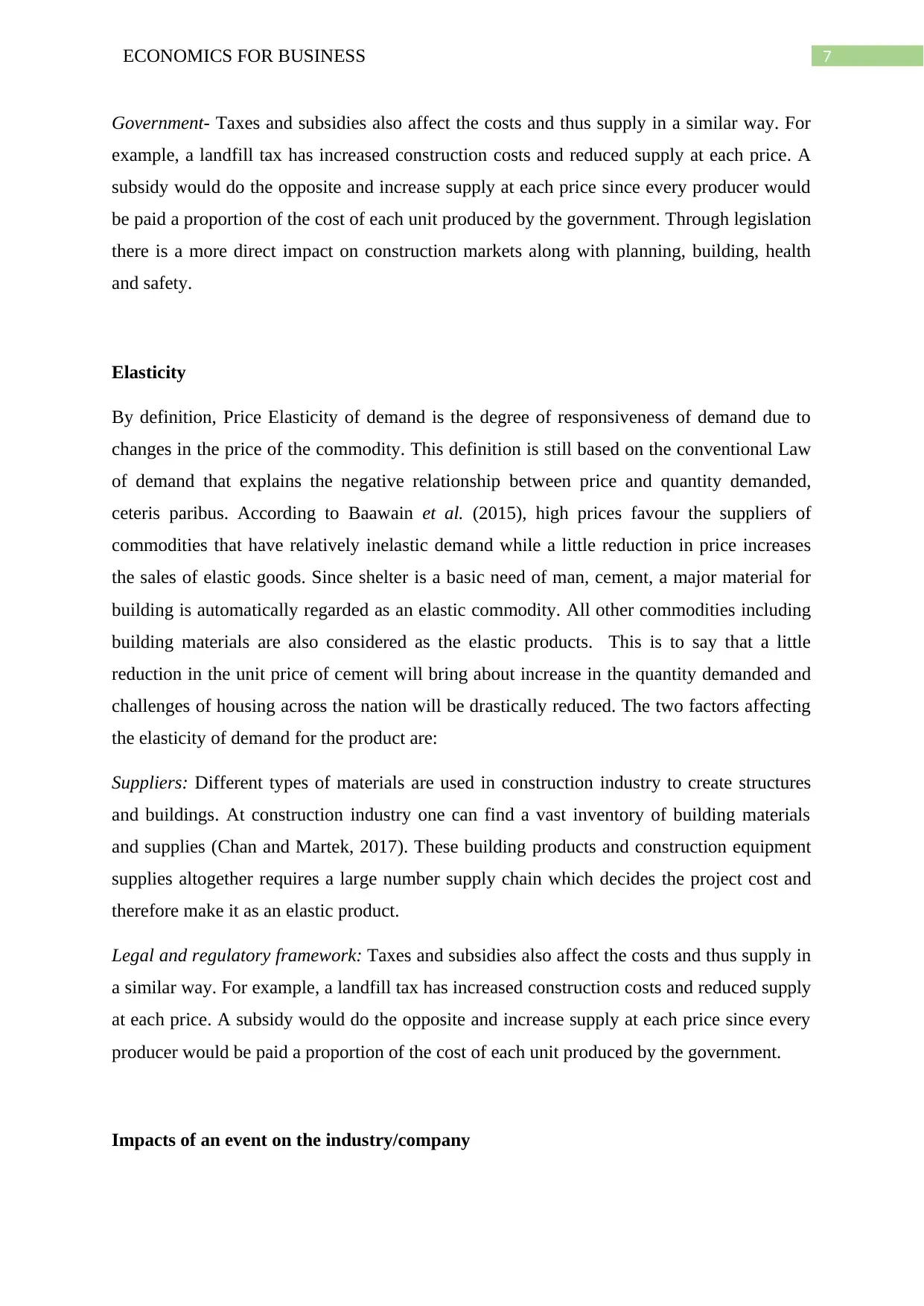
7ECONOMICS FOR BUSINESS
Government- Taxes and subsidies also affect the costs and thus supply in a similar way. For
example, a landfill tax has increased construction costs and reduced supply at each price. A
subsidy would do the opposite and increase supply at each price since every producer would
be paid a proportion of the cost of each unit produced by the government. Through legislation
there is a more direct impact on construction markets along with planning, building, health
and safety.
Elasticity
By definition, Price Elasticity of demand is the degree of responsiveness of demand due to
changes in the price of the commodity. This definition is still based on the conventional Law
of demand that explains the negative relationship between price and quantity demanded,
ceteris paribus. According to Baawain et al. (2015), high prices favour the suppliers of
commodities that have relatively inelastic demand while a little reduction in price increases
the sales of elastic goods. Since shelter is a basic need of man, cement, a major material for
building is automatically regarded as an elastic commodity. All other commodities including
building materials are also considered as the elastic products. This is to say that a little
reduction in the unit price of cement will bring about increase in the quantity demanded and
challenges of housing across the nation will be drastically reduced. The two factors affecting
the elasticity of demand for the product are:
Suppliers: Different types of materials are used in construction industry to create structures
and buildings. At construction industry one can find a vast inventory of building materials
and supplies (Chan and Martek, 2017). These building products and construction equipment
supplies altogether requires a large number supply chain which decides the project cost and
therefore make it as an elastic product.
Legal and regulatory framework: Taxes and subsidies also affect the costs and thus supply in
a similar way. For example, a landfill tax has increased construction costs and reduced supply
at each price. A subsidy would do the opposite and increase supply at each price since every
producer would be paid a proportion of the cost of each unit produced by the government.
Impacts of an event on the industry/company
Government- Taxes and subsidies also affect the costs and thus supply in a similar way. For
example, a landfill tax has increased construction costs and reduced supply at each price. A
subsidy would do the opposite and increase supply at each price since every producer would
be paid a proportion of the cost of each unit produced by the government. Through legislation
there is a more direct impact on construction markets along with planning, building, health
and safety.
Elasticity
By definition, Price Elasticity of demand is the degree of responsiveness of demand due to
changes in the price of the commodity. This definition is still based on the conventional Law
of demand that explains the negative relationship between price and quantity demanded,
ceteris paribus. According to Baawain et al. (2015), high prices favour the suppliers of
commodities that have relatively inelastic demand while a little reduction in price increases
the sales of elastic goods. Since shelter is a basic need of man, cement, a major material for
building is automatically regarded as an elastic commodity. All other commodities including
building materials are also considered as the elastic products. This is to say that a little
reduction in the unit price of cement will bring about increase in the quantity demanded and
challenges of housing across the nation will be drastically reduced. The two factors affecting
the elasticity of demand for the product are:
Suppliers: Different types of materials are used in construction industry to create structures
and buildings. At construction industry one can find a vast inventory of building materials
and supplies (Chan and Martek, 2017). These building products and construction equipment
supplies altogether requires a large number supply chain which decides the project cost and
therefore make it as an elastic product.
Legal and regulatory framework: Taxes and subsidies also affect the costs and thus supply in
a similar way. For example, a landfill tax has increased construction costs and reduced supply
at each price. A subsidy would do the opposite and increase supply at each price since every
producer would be paid a proportion of the cost of each unit produced by the government.
Impacts of an event on the industry/company
Paraphrase This Document
Need a fresh take? Get an instant paraphrase of this document with our AI Paraphraser
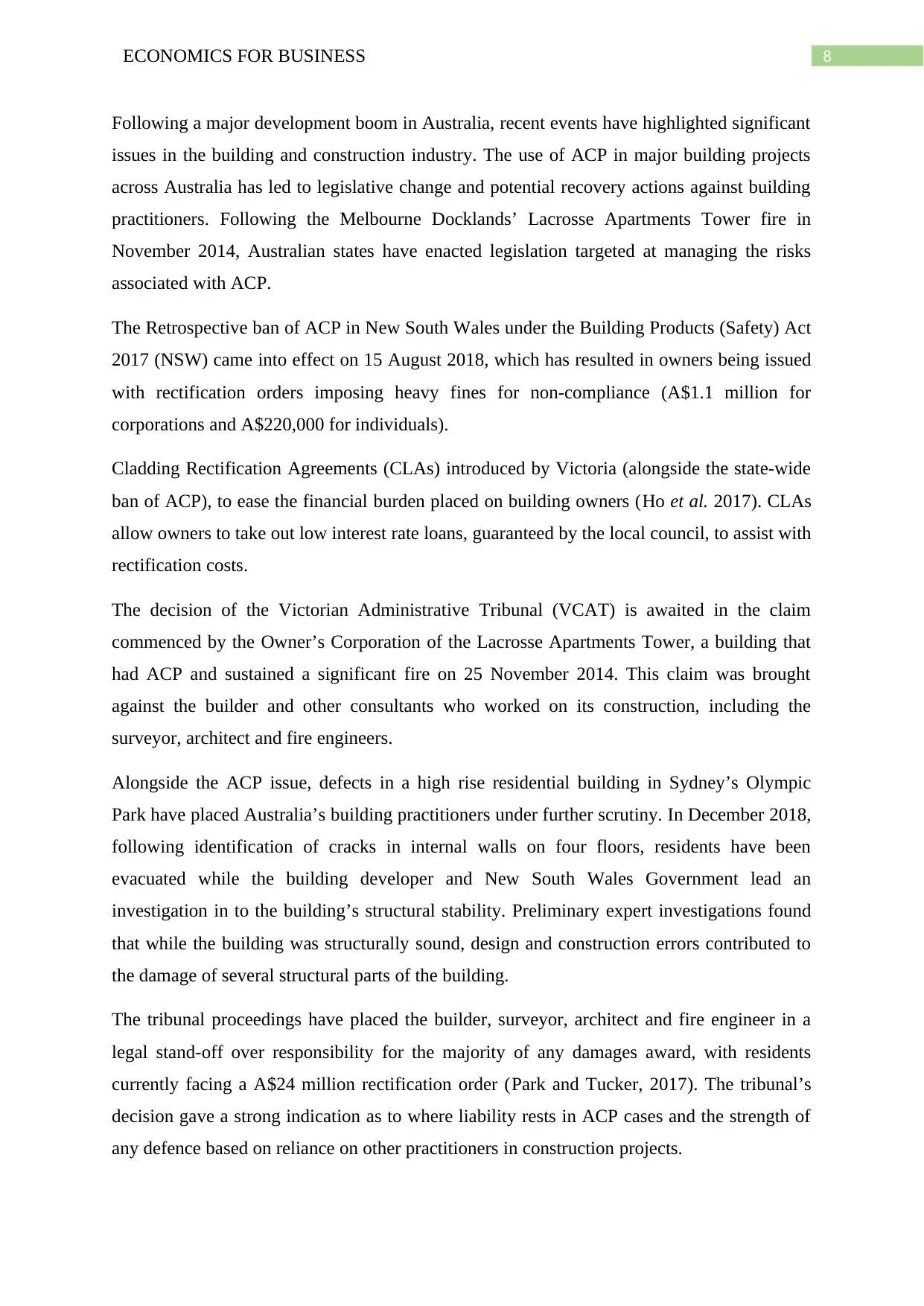
8ECONOMICS FOR BUSINESS
Following a major development boom in Australia, recent events have highlighted significant
issues in the building and construction industry. The use of ACP in major building projects
across Australia has led to legislative change and potential recovery actions against building
practitioners. Following the Melbourne Docklands’ Lacrosse Apartments Tower fire in
November 2014, Australian states have enacted legislation targeted at managing the risks
associated with ACP.
The Retrospective ban of ACP in New South Wales under the Building Products (Safety) Act
2017 (NSW) came into effect on 15 August 2018, which has resulted in owners being issued
with rectification orders imposing heavy fines for non-compliance (A$1.1 million for
corporations and A$220,000 for individuals).
Cladding Rectification Agreements (CLAs) introduced by Victoria (alongside the state-wide
ban of ACP), to ease the financial burden placed on building owners (Ho et al. 2017). CLAs
allow owners to take out low interest rate loans, guaranteed by the local council, to assist with
rectification costs.
The decision of the Victorian Administrative Tribunal (VCAT) is awaited in the claim
commenced by the Owner’s Corporation of the Lacrosse Apartments Tower, a building that
had ACP and sustained a significant fire on 25 November 2014. This claim was brought
against the builder and other consultants who worked on its construction, including the
surveyor, architect and fire engineers.
Alongside the ACP issue, defects in a high rise residential building in Sydney’s Olympic
Park have placed Australia’s building practitioners under further scrutiny. In December 2018,
following identification of cracks in internal walls on four floors, residents have been
evacuated while the building developer and New South Wales Government lead an
investigation in to the building’s structural stability. Preliminary expert investigations found
that while the building was structurally sound, design and construction errors contributed to
the damage of several structural parts of the building.
The tribunal proceedings have placed the builder, surveyor, architect and fire engineer in a
legal stand-off over responsibility for the majority of any damages award, with residents
currently facing a A$24 million rectification order (Park and Tucker, 2017). The tribunal’s
decision gave a strong indication as to where liability rests in ACP cases and the strength of
any defence based on reliance on other practitioners in construction projects.
Following a major development boom in Australia, recent events have highlighted significant
issues in the building and construction industry. The use of ACP in major building projects
across Australia has led to legislative change and potential recovery actions against building
practitioners. Following the Melbourne Docklands’ Lacrosse Apartments Tower fire in
November 2014, Australian states have enacted legislation targeted at managing the risks
associated with ACP.
The Retrospective ban of ACP in New South Wales under the Building Products (Safety) Act
2017 (NSW) came into effect on 15 August 2018, which has resulted in owners being issued
with rectification orders imposing heavy fines for non-compliance (A$1.1 million for
corporations and A$220,000 for individuals).
Cladding Rectification Agreements (CLAs) introduced by Victoria (alongside the state-wide
ban of ACP), to ease the financial burden placed on building owners (Ho et al. 2017). CLAs
allow owners to take out low interest rate loans, guaranteed by the local council, to assist with
rectification costs.
The decision of the Victorian Administrative Tribunal (VCAT) is awaited in the claim
commenced by the Owner’s Corporation of the Lacrosse Apartments Tower, a building that
had ACP and sustained a significant fire on 25 November 2014. This claim was brought
against the builder and other consultants who worked on its construction, including the
surveyor, architect and fire engineers.
Alongside the ACP issue, defects in a high rise residential building in Sydney’s Olympic
Park have placed Australia’s building practitioners under further scrutiny. In December 2018,
following identification of cracks in internal walls on four floors, residents have been
evacuated while the building developer and New South Wales Government lead an
investigation in to the building’s structural stability. Preliminary expert investigations found
that while the building was structurally sound, design and construction errors contributed to
the damage of several structural parts of the building.
The tribunal proceedings have placed the builder, surveyor, architect and fire engineer in a
legal stand-off over responsibility for the majority of any damages award, with residents
currently facing a A$24 million rectification order (Park and Tucker, 2017). The tribunal’s
decision gave a strong indication as to where liability rests in ACP cases and the strength of
any defence based on reliance on other practitioners in construction projects.
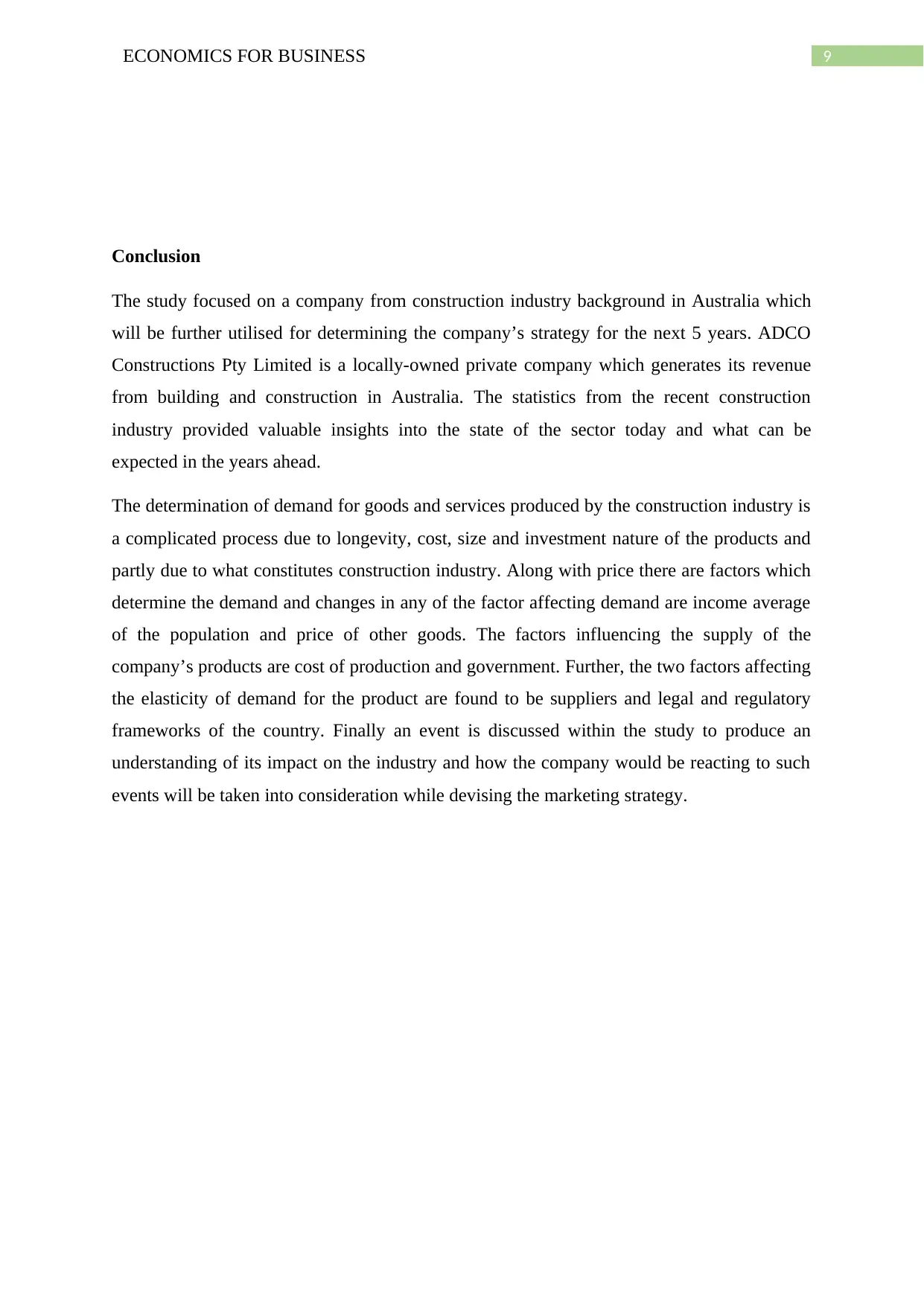
9ECONOMICS FOR BUSINESS
Conclusion
The study focused on a company from construction industry background in Australia which
will be further utilised for determining the company’s strategy for the next 5 years. ADCO
Constructions Pty Limited is a locally-owned private company which generates its revenue
from building and construction in Australia. The statistics from the recent construction
industry provided valuable insights into the state of the sector today and what can be
expected in the years ahead.
The determination of demand for goods and services produced by the construction industry is
a complicated process due to longevity, cost, size and investment nature of the products and
partly due to what constitutes construction industry. Along with price there are factors which
determine the demand and changes in any of the factor affecting demand are income average
of the population and price of other goods. The factors influencing the supply of the
company’s products are cost of production and government. Further, the two factors affecting
the elasticity of demand for the product are found to be suppliers and legal and regulatory
frameworks of the country. Finally an event is discussed within the study to produce an
understanding of its impact on the industry and how the company would be reacting to such
events will be taken into consideration while devising the marketing strategy.
Conclusion
The study focused on a company from construction industry background in Australia which
will be further utilised for determining the company’s strategy for the next 5 years. ADCO
Constructions Pty Limited is a locally-owned private company which generates its revenue
from building and construction in Australia. The statistics from the recent construction
industry provided valuable insights into the state of the sector today and what can be
expected in the years ahead.
The determination of demand for goods and services produced by the construction industry is
a complicated process due to longevity, cost, size and investment nature of the products and
partly due to what constitutes construction industry. Along with price there are factors which
determine the demand and changes in any of the factor affecting demand are income average
of the population and price of other goods. The factors influencing the supply of the
company’s products are cost of production and government. Further, the two factors affecting
the elasticity of demand for the product are found to be suppliers and legal and regulatory
frameworks of the country. Finally an event is discussed within the study to produce an
understanding of its impact on the industry and how the company would be reacting to such
events will be taken into consideration while devising the marketing strategy.
⊘ This is a preview!⊘
Do you want full access?
Subscribe today to unlock all pages.

Trusted by 1+ million students worldwide
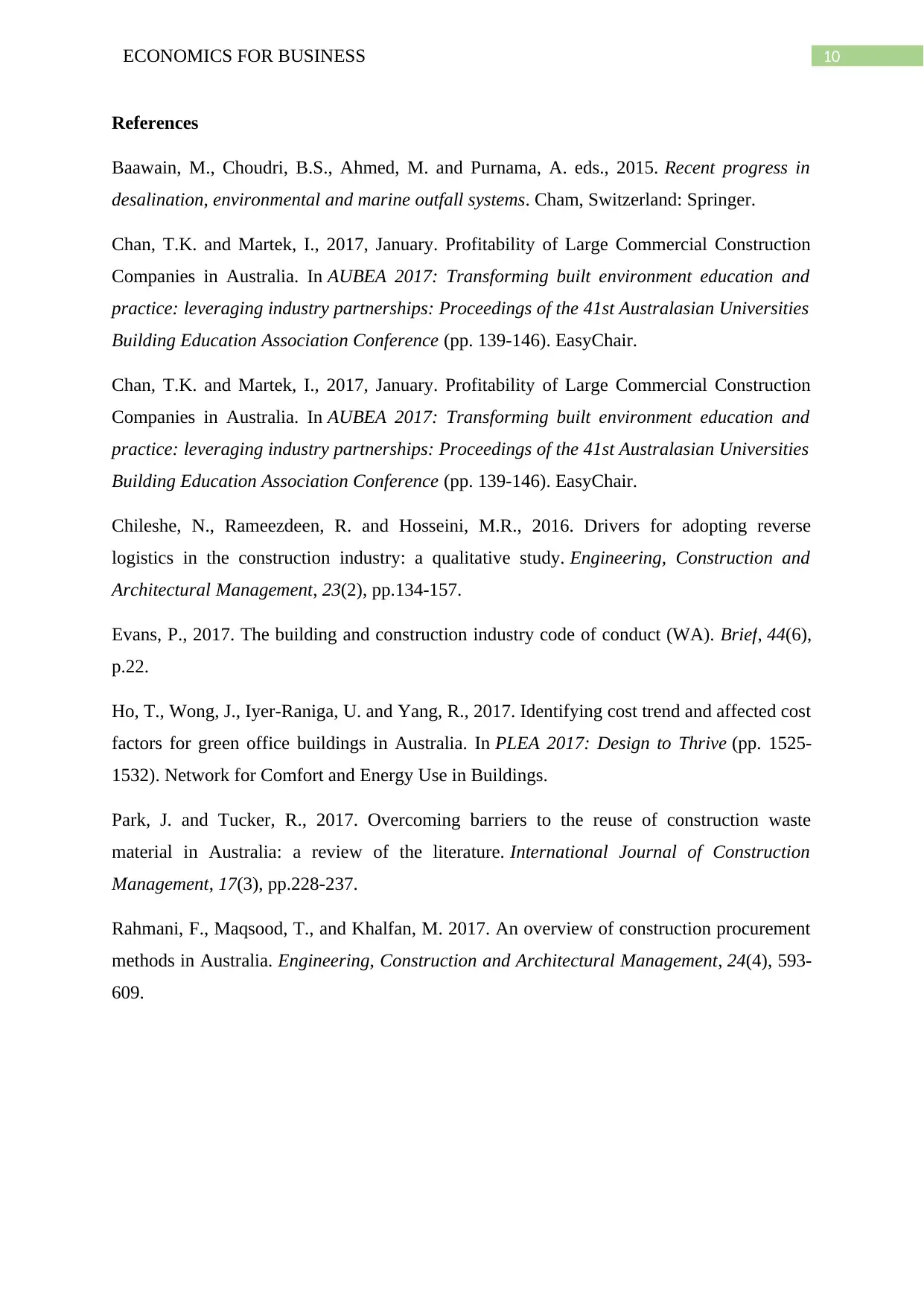
10ECONOMICS FOR BUSINESS
References
Baawain, M., Choudri, B.S., Ahmed, M. and Purnama, A. eds., 2015. Recent progress in
desalination, environmental and marine outfall systems. Cham, Switzerland: Springer.
Chan, T.K. and Martek, I., 2017, January. Profitability of Large Commercial Construction
Companies in Australia. In AUBEA 2017: Transforming built environment education and
practice: leveraging industry partnerships: Proceedings of the 41st Australasian Universities
Building Education Association Conference (pp. 139-146). EasyChair.
Chan, T.K. and Martek, I., 2017, January. Profitability of Large Commercial Construction
Companies in Australia. In AUBEA 2017: Transforming built environment education and
practice: leveraging industry partnerships: Proceedings of the 41st Australasian Universities
Building Education Association Conference (pp. 139-146). EasyChair.
Chileshe, N., Rameezdeen, R. and Hosseini, M.R., 2016. Drivers for adopting reverse
logistics in the construction industry: a qualitative study. Engineering, Construction and
Architectural Management, 23(2), pp.134-157.
Evans, P., 2017. The building and construction industry code of conduct (WA). Brief, 44(6),
p.22.
Ho, T., Wong, J., Iyer-Raniga, U. and Yang, R., 2017. Identifying cost trend and affected cost
factors for green office buildings in Australia. In PLEA 2017: Design to Thrive (pp. 1525-
1532). Network for Comfort and Energy Use in Buildings.
Park, J. and Tucker, R., 2017. Overcoming barriers to the reuse of construction waste
material in Australia: a review of the literature. International Journal of Construction
Management, 17(3), pp.228-237.
Rahmani, F., Maqsood, T., and Khalfan, M. 2017. An overview of construction procurement
methods in Australia. Engineering, Construction and Architectural Management, 24(4), 593-
609.
References
Baawain, M., Choudri, B.S., Ahmed, M. and Purnama, A. eds., 2015. Recent progress in
desalination, environmental and marine outfall systems. Cham, Switzerland: Springer.
Chan, T.K. and Martek, I., 2017, January. Profitability of Large Commercial Construction
Companies in Australia. In AUBEA 2017: Transforming built environment education and
practice: leveraging industry partnerships: Proceedings of the 41st Australasian Universities
Building Education Association Conference (pp. 139-146). EasyChair.
Chan, T.K. and Martek, I., 2017, January. Profitability of Large Commercial Construction
Companies in Australia. In AUBEA 2017: Transforming built environment education and
practice: leveraging industry partnerships: Proceedings of the 41st Australasian Universities
Building Education Association Conference (pp. 139-146). EasyChair.
Chileshe, N., Rameezdeen, R. and Hosseini, M.R., 2016. Drivers for adopting reverse
logistics in the construction industry: a qualitative study. Engineering, Construction and
Architectural Management, 23(2), pp.134-157.
Evans, P., 2017. The building and construction industry code of conduct (WA). Brief, 44(6),
p.22.
Ho, T., Wong, J., Iyer-Raniga, U. and Yang, R., 2017. Identifying cost trend and affected cost
factors for green office buildings in Australia. In PLEA 2017: Design to Thrive (pp. 1525-
1532). Network for Comfort and Energy Use in Buildings.
Park, J. and Tucker, R., 2017. Overcoming barriers to the reuse of construction waste
material in Australia: a review of the literature. International Journal of Construction
Management, 17(3), pp.228-237.
Rahmani, F., Maqsood, T., and Khalfan, M. 2017. An overview of construction procurement
methods in Australia. Engineering, Construction and Architectural Management, 24(4), 593-
609.
1 out of 10
Related Documents
Your All-in-One AI-Powered Toolkit for Academic Success.
+13062052269
info@desklib.com
Available 24*7 on WhatsApp / Email
![[object Object]](/_next/static/media/star-bottom.7253800d.svg)
Unlock your academic potential
Copyright © 2020–2025 A2Z Services. All Rights Reserved. Developed and managed by ZUCOL.





